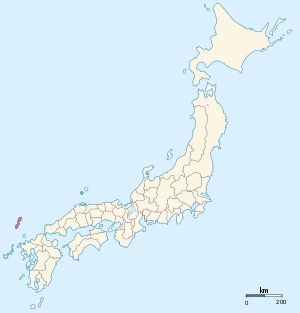
Tsushima Province
Encyclopedia

Tsushima Island
Tsushima Island is an island of the Japanese Archipelago situated in the middle of the Tsushima Strait at 34°25'N and 129°20'E. The main island of Tsushima was once a single island, but the island was divided into two in 1671 by the Ōfunakosiseto canal and into three in 1900 by the Manzekiseto canal...
which occupied the area corresponding to modern-day Tsushima
Tsushima, Nagasaki
is a city governed by Nagasaki Prefecture, Japan. It is the only city of Tsushima Subprefecture and it encompasses all of Tsushima Island Archipelago, which lies in the Tsushima Strait north of Nagasaki on the western side of Kyūshū, the southernmost mainland island of Japan. the city has an...
, Nagasaki
Nagasaki Prefecture
is a prefecture of Japan located on the island of Kyūshū. The capital is the city of Nagasaki.- History :Nagasaki Prefecture was created by merging of the western half of the former province of Hizen with the island provinces of Tsushima and Iki...
. It was sometimes called .
Political History
The origin of Tsushima Province is unclear. It is possible that Tsushima was recognized as a province of the Yamato Court in the 5th century. Under the RitsuryōRitsuryo
is the historical law system based on the philosophies of Confucianism and Chinese Legalism in Japan. The political system in accord to Ritsuryō is called "Ritsuryō-sei"...
system, Tsushima formally became a province.
Tsushima Province has been a strategic area that took a major role in the national defense against possible invasions from the continent and in trade with Korea. After Japan was defeated by Silla at the Battle of Baekgang
Battle of Baekgang
The Battle of Baekgang, also known as Battle of Baekgang-gu or by the Japanese name Battle of Hakusukinoe , was a battle between Baekje restoration forces and their ally, Yamato Japan, against the allied forces of Silla and the Tang Dynasty of ancient China...
in 663, Kaneda Castle was constructed on this island.
Tsushima Province had been controlled by the Tsushima no Kuni no miyatsuko
Kuni no miyatsuko
Kuni no miyatsuko were officials in ancient Japan at the time of the Yamato court.They were in charge of provinces , although it is not always very clear what those provinces were...
until the Heian Period
Heian period
The is the last division of classical Japanese history, running from 794 to 1185. The period is named after the capital city of Heian-kyō, or modern Kyōto. It is the period in Japanese history when Buddhism, Taoism and other Chinese influences were at their height...
. This clan was later replaced by the Ahiru clan
Abiru clan
The was a Japanese clan which served the Kamakura shogunate as local officials on Tsushima. It is believed the clan may have been derived from the Taira clan, but the validity of this notion is not fully evident from primary sources....
. The Sō clan
So clan
The Sō were a Japanese clan claiming descent from Taira Tomomori. The clan governed and held Tsushima Island from the 13th-century through the late 19th-century, from the Kamakura period until the end of the Edo period and the Meiji restoration....
rose to power around the middle 13th century and seized control of the entire island in the late 15th century. During the Edo Period
Edo period
The , or , is a division of Japanese history which was ruled by the shoguns of the Tokugawa family, running from 1603 to 1868. The political entity of this period was the Tokugawa shogunate....
, Tsushima Province was dominated by the Tsushima Fuchu domain
Tsushima Fuchu domain
The Tsushima Fuchū domain , also called the Tsushima domain, was a domain of Japan during the Edo period that controlled Tsushima Province and a small portion of Hizen Province. It was ruled by the Sō clan...
(Izuhara domain) of the So clan. It was put in charge of diplomacy and monopolized trade with the Joseon Dynasty
Joseon Dynasty
Joseon , was a Korean state founded by Taejo Yi Seong-gye that lasted for approximately five centuries. It was founded in the aftermath of the overthrow of the Goryeo at what is today the city of Kaesong. Early on, Korea was retitled and the capital was relocated to modern-day Seoul...
of Korea.
As a result of the abolition of the han system
Abolition of the han system
The was an act, in 1871, of the new Meiji government of the Empire of Japan to replace the traditional feudal domain system and to introduce centralized government authority . This process marked the culmination of the Meiji Restoration in that all daimyo were required to return their authority...
, the Tsushima Fuchu domain became Izuhara Prefecture in 1871. In the same year, Izuhara Prefecture was merged into Imari Prefecture, which was renamed Saga Prefecture
Saga Prefecture
is located in the northwest part of the island of Kyūshū, Japan. It touches both the Sea of Japan and the Ariake Sea. The western part of the prefecture is a region famous for producing ceramics and porcelain, particularly the towns of Karatsu, Imari, and Arita...
in 1872. Tsushima was transferred to Nagasaki Prefecture in 1872.
Districts
Throughout history, Tsushima Province consisted of two districts:- Kamiagata (上県)
- Shimoagata (下県)
The capital of Tsushima province was located at Izuhara. In the modern local municipality system, they were divided into Kamiagata and Shimoagata districts respectively, and were subsequently merged into the city of Tsushima
Tsushima, Nagasaki
is a city governed by Nagasaki Prefecture, Japan. It is the only city of Tsushima Subprefecture and it encompasses all of Tsushima Island Archipelago, which lies in the Tsushima Strait north of Nagasaki on the western side of Kyūshū, the southernmost mainland island of Japan. the city has an...
today.

